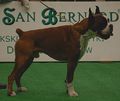Gingival Hyperplasia
| This article has been peer reviewed but is awaiting expert review. If you would like to help with this, please see more information about expert reviewing. |
Typical Signalment
- Common condition in dogs but less common in cats
- The following breeds are predisposed:
Description
Gingival hyperplasia often appears as pink, hyperaemic and ulcerated lesions that can be either firm or soft. There can be varying amounts of pigmentation reflecting the normal pigmentation of the oral mucosa. Crowns of teeth are often partially or completely covered by the hyperplastic gingiva forming a potential space or pocket between the gingiva and the crown where plaque is able to accumulate.
Gingival hyperplasia can be described as:
- Focal lesions
- Multiple focal lesions
- Generalised
- Combinations of the above
It is thought to be the result of an imbalance in the plaque/host tissue response. There are many factors that can cause this condition. These include the following:
- Drug-induced
- Ciclosporin
- Phenytoin
- Calcium channel blockers
- Chronic irritation
- Dental plaque
- Odontoclastic resorptive lesions
- Neoplasm
- Mechanical irritation
Diagnosis
Clinical Signs
Depend on the severity of gingival hyperplasia and the degree to which the teeth are covered but include:
- pain on mastication
- haemorrhage (mild to moderate)
- reluctance to eat
- drooling
- dysphagia
Diagnostic Imaging
Oral radiographs should be taken to rule out concurrent conditions. One such condition is periodontitis which is demonstrated radiographically by alveolar bone loss associated with pocket formation between the tooth crown and gingiva.
Biopsy
Biopsy samples should include those areas of gingiva that show signs of inflammation with a softer than normal texture. Any gingiva with radiographic signs of bone involvement should also be sampled.
Treatment
The suspected cause of the condition should be corrected first. This may include a multimodal treatment plan aimed at controlling plaque formation including teeth brushing and providing the animal with sticks/toys that clean the teeth crowns.
- Gingivectomy and gingivoplasty - should be carried out under general anaesthetic if significant pseudo-pockets are present between the gingiva and teeth crowns. The aim should be to eliminate the pseudopockets and re-establish the normal anatomy of the gingival margin.
- Electrosurgery and Laser surgery - care must be taken with electrosurgery to avoid contact between the teeth crowns and the electrodes to prevent irreversible heat damage to the pulp.
Prognosis
The prognosis following surgical excision and histopathology is good. However, local recurrence is possible but less common if a treatment plan aimed at reducing plaque formation is implemented. A re-examination of the patient should be carried out at least every 6 months to assess for signs of recurrence and the sufficiency of plaque control measures.
References
- Tutt, C., Deeprose, J. and Crossley, D. (2007) BSAVA Manual of Canine and Feline Dentistry (3rd Edition) BSAVA
- Merck & Co (2008) The Merck Veterinary Manual



